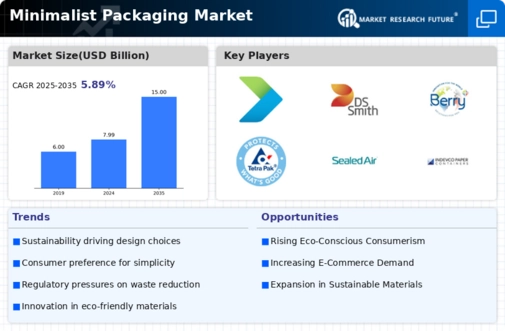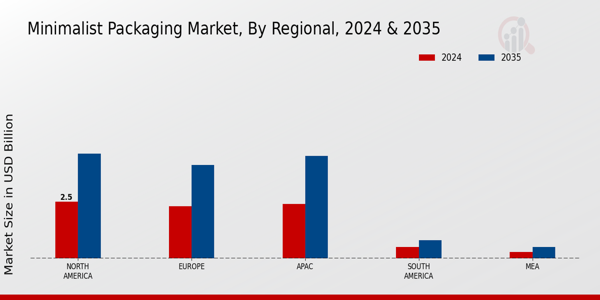Cost Efficiency
Cost efficiency plays a pivotal role in the Global Minimalist Packaging Market Industry. By adopting minimalist packaging, companies can significantly reduce material costs and logistics expenses. Streamlined designs not only lower production costs but also enhance shipping efficiency, as lighter packages reduce transportation expenses. For example, brands like Coca-Cola have implemented minimalist packaging strategies, resulting in substantial savings. This focus on cost-effectiveness is expected to drive the market's growth, with projections indicating a rise to 15.0 USD Billion by 2035, showcasing the financial benefits of minimalist approaches.
Regulatory Support
Regulatory support for sustainable packaging initiatives is emerging as a significant driver in the Global Minimalist Packaging Market Industry. Governments worldwide are implementing policies aimed at reducing plastic waste and promoting eco-friendly packaging solutions. For instance, the European Union has introduced regulations that encourage the use of recyclable materials in packaging. Such policies not only foster innovation in minimalist packaging designs but also create a favorable environment for market growth. As regulations tighten, companies are likely to invest in minimalist packaging strategies, further propelling the market forward.
Consumer Preferences
Consumer preferences are shifting towards simplicity and functionality, which is a key driver in the Global Minimalist Packaging Market Industry. Modern consumers often favor products that feature straightforward, clean designs that communicate brand values effectively. This trend is particularly evident in sectors such as cosmetics and food, where brands like Aesop and Blue Apron utilize minimalist packaging to enhance user experience. As consumer demand for aesthetically pleasing yet functional packaging increases, the market is anticipated to grow at a CAGR of 5.89% from 2025 to 2035, indicating a sustained interest in minimalist solutions.
Sustainability Trends
The Global Minimalist Packaging Market Industry is increasingly influenced by sustainability trends. Consumers are becoming more environmentally conscious, demanding packaging solutions that minimize waste and utilize recyclable materials. This shift is evident as brands adopt minimalist packaging designs that reduce excess material while maintaining product integrity. For instance, companies like Unilever have committed to reducing plastic use, aligning with the growing consumer preference for eco-friendly products. The market is projected to reach 7.99 USD Billion in 2024, reflecting a robust response to these sustainability demands.
Market Growth Projections
The Global Minimalist Packaging Market Industry is poised for substantial growth, with projections indicating a market value of 7.99 USD Billion in 2024 and an anticipated increase to 15.0 USD Billion by 2035. This growth reflects a compound annual growth rate (CAGR) of 5.89% from 2025 to 2035, driven by factors such as sustainability trends, cost efficiency, and evolving consumer preferences. The market's expansion is indicative of a broader shift towards minimalist packaging solutions across various sectors, highlighting the increasing importance of packaging in brand strategy.
Technological Advancements
Technological advancements are transforming the Global Minimalist Packaging Market Industry by enabling innovative packaging solutions. Developments in materials science and printing technology allow for the creation of lightweight, durable, and visually appealing packaging. For example, advancements in biodegradable materials are facilitating the production of minimalist packaging that meets consumer demands for sustainability. As technology continues to evolve, it is likely to enhance the efficiency and effectiveness of minimalist packaging designs, contributing to the market's projected growth trajectory.















